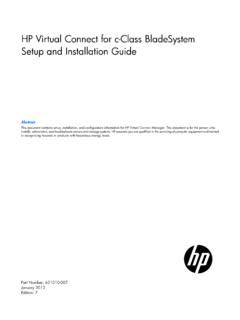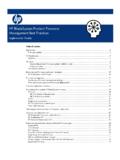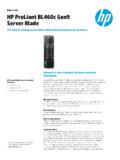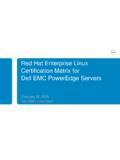Transcription of Sizing guide for Microsoft Hyper-V on HP server and ...
1 Executive summary .. 2 Hyper-V Sizing : server capacity considerations .. 2 Application processor utilization requirements .. 3 Application memory usage requirements .. 5 Application network throughput requirements .. 6 HP ProLiant server component capacity Sizing matrix .. 7 Hyper-V Sizing : storage considerations .. 9 HP storage solutions for Hyper-V .. 10 ProLiant server local storage .. 10 HP StorageWorks 2000fc Modular Smart Array .. 10 HP P4500 LeftHand Virtualization SAN .. 11 HP StorageWorks 4400 Enterprise Virtual Array (EVA4400) .. 11 HP StorageWorks 6100 Enterprise Virtual Array (EVA6100) .. 12 HP StorageWorks 8100 Enterprise Virtual Array (EVA8100) .. 12 HP StorageWorks 6400 Enterprise Virtual Array (EVA6400) .. 13 HP StorageWorks 8400 Enterprise Virtual Array (EVA8400).
2 14 HP StorageWorks XP24000/XP20000 Disk Arrays .. 15 Appendix A: Hyper-V processor settings .. 16 Appendix B: Hyper-V memory settings .. 28 Appendix C: Hyper-V network settings .. 30 Appendix D: HP Unified Infrastructure Management .. 35 Appendix E: HP Virtual Connect Flex-10 10Gb technology .. 36 For more information .. 37 Sizing guide for Microsoft Hyper-V on HP server and storage technologies 2 Executive summary Sizing a Microsoft Hyper-V environment can seem like a daunting task. While the actual process can be very complicated, there are steps you can take to better understand how to successfully accomplish this task. This white paper discusses these steps and presents a Sizing methodology for Microsoft Hyper-V environments.
3 A static list of recommended HP server and storage hardware for running applications on top of Microsoft s virtualization software technology, called Hyper-V , is also included. This paper presents basic Sizing guidance for deploying applications into a Microsoft Hyper-V virtualized architecture. It focuses on Hyper-V Sizing from a generic or horizontal view, and does not focus on any specific application running on top of Hyper-V . Instead, it provides guidance on the key factors on which to focus for any application running on Hyper-V . The major Hyper-V consideration discussed in this white paper is the number of virtual machines (VMs) that can be run on a physical host server . This information should be used as Sizing guidance and is not a detailed blueprint for implementing a Hyper-V architecture.
4 Additional Hyper-V configuration recommendations, including a detailed server and storage bill of materials (BOM), can be obtained by downloading and running the HP Sizing tool for Hyper-V located on the HP ActiveAnswers website. Target audience: This paper is for a technical audience needing assistance with Sizing a Hyper-V environment using HP server and storage technology. You should have a good technical understanding of the performance and capacity requirements of the applications you plan on running on top of Hyper-V as well as a deep understanding of Hyper-V . For additional details about Hyper-V , refer to the HP ActiveAnswers website for Microsoft Hyper-V . This white paper is based on testing performed in the fall of 2008.
5 Hyper-V Sizing : server capacity considerations When attempting to determine how many virtual machines (VMs) are needed to properly run an application or a set of applications on Hyper-V , it is first necessary to calculate how many VMs can be run on a single physical host server . Once you have identified how many VMs can run simultaneously on a single server you can calculate how many servers you need to support your Hyper-V application infrastructure. The first step in this process is identifying the optimum performance requirements of the three major server components your applications will consume: processor utilization, memory usage, and network throughput. Note: While there are other server components that may affect performance, this paper focuses on the three server components mentioned above as they can have the biggest impact on server performance.
6 Understanding your application s performance requirements before moving to a virtualized environment is the first part in Sizing a Hyper-V architecture. 3 Application processor utilization requirements Understanding how much of a physical host server s processor a given application will need is the primary requirement for determining the number of VMs that can be run simultaneously on a physical server . Certainly, the other two server components discussed in this paper, memory usage and network throughput, are important server resources in deciding the number of VMs to run on a physical server ; however, these two server resources can be scaled-up within a physical server much more readily than the server s processor resources.
7 Once all of the processor sockets within a physical server are populated, the only way to scale-up processor power is to install faster processors, if the server motherboard will even support such an upgrade. Therefore, the first and most important step in considering how many VMs can simultaneously run on a server is determining the server s processor utilization capacity. This section discusses a simple, basic application processor utilization capacity measuring process. HP has published a free downloadable Hyper-V Sizing tool that is more sophisticated and complex and requires the user to enter a good amount of application performance and capacity details. The Hyper-V Sizing tool produces rich, configurable Hyper-V configurations based on granular user application and Hyper-V usage requirements.
8 The Hyper-V Sizing tool also produces a server and storage bill of materials (BOM) that details the server and storage hardware recommendations. The HP Sizing tool for Hyper-V can be found on the HP ActiveAnswers website. Most applications running on a physical server do not use the full measure of a server s processor capacity. Measuring your application s current processor requirements or estimating your future applications requirements is important in Sizing your Hyper-V architecture. For example, in Hyper-V you can theoretically create up to 512 VMs and simultaneously run up to 128 VMs on a single server . If you were to try and start all of them all at the same time, however, one of two things will most likely happen; either most of the VMs will not start because they do not have processor resources, or they will all start, but the applications running on the VMs will have very poor performance because of inadequate processor resources.
9 In order to prevent such a situation from occurring, HP recommends following the guidelines below: 1. Identify the optimum amount of processing power, measured in processor utilization percentage, that your application will need in order to run properly on a single physical server . This data point can be obtained by recording the average processor utilization performance measurements from each physical server the application is currently running on. Take an average of these server processor utilization measurements to derive a single optimum processor utilization data point to be used in the calculation. If this data point is not available, then an informed estimate will need to be made. 2. Keep a minimum reserve of 30% processor utilization for the host server .
10 (Use a maximum of 70% processor utilization capacity for the VMs.) This will allow for the occasional spike in processor utilization encountered by most applications. 3. Divide the maximum processor utilization capacity by the optimum processor utilization you want your application to run at. 4. Multiply the result by 90% to calculate the approximate number of VMs that can run on a single physical host server . (This step accounts for a 10% overhead for going from physical to virtual machines.) Examples of this process: Example 1: 1. You estimate that the optimum processor utilization for your application is 2%. 2. You reserve 30% of the total processor capacity for the physical host server . 4 3. The approximate number of VMs that can be run simultaneously = (100-30) / 2 * 90% = ~31 VMs.














